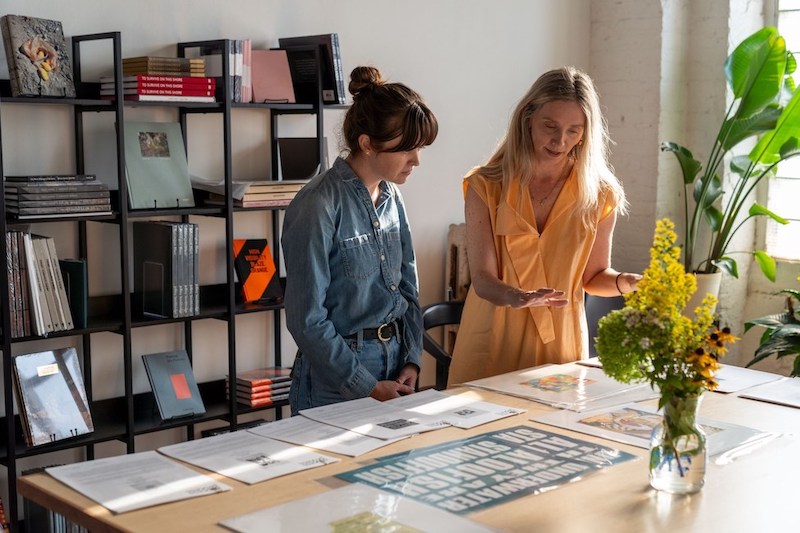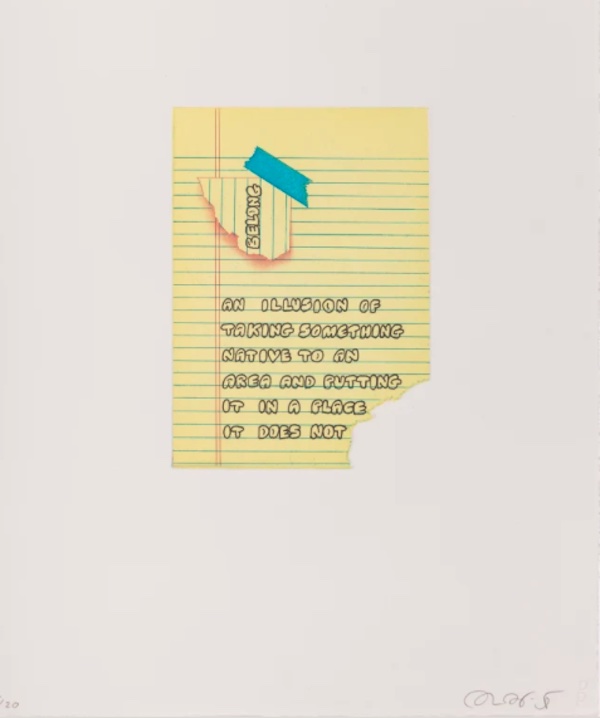Why Collect Prints? A Primer from Process/Process

Editor's Note: Jessica Cochran and Angee Lennard launched a new printmaking venture earlier this year called Process / Process. They have been releasing special print editions of works by area artists and also trying to educate the public about why collecting prints and works on paper is fun, accessible and an affordable means of supporting contemporary artists in a market that can sometimes seem out of reach. There are many artists in Chicago and beyond working in printmaking – sometimes exclusively as their chosen medium and sometimes as a means of creating more affordable versions of their work (painters and sculptors can work in printmaking too.)
The feature below was posted by Process/Process on October 21, 2024. To learn more visit process-process.com

By JESSICA COCHRAN AND ANGEE LENNARD of PROCESS/PROCESS
Sometimes artists make prints on their own, and sometimes they “publish” in collaboration with a gallery or studio like Process/Process. As Nate Freeman wrote in an explainer for Artsy, “So, aren’t prints just, like, copies of an artist’s big, famous works?”
Well, no. In our case, they are original–handmade–artworks, and always incredibly meaningful expressions of an artist’s practice. A print might typify an artist’s visual vocabulary, for example, or it might offer an experimental interlude. Here are just a few reasons to collect what we like to call “multiple originals.”
ORIGINAL ARTWORKS
While prints may pull imagery or themes from an artist's existing body of work, prints rarely just replicate a painting or drawing. As artworks, prints carry their own meaning and potential. An artist who more typically paints, for example, may utilize the etching process to draw an image by hand directly onto a copper plate (see Figure 1). When pulled from the press, the resulting impressions are signed, dated, and numbered by the artist.
We are often asked: how involved is the artist in the printing process? It varies. Sometimes an artist works side by side with us in the shop or they actually work “on press”; and other times, an artist turns over the printing entirely to us–that is, after they create the original plate, drawing, collage, or source material from which we work. At every step, however, the printer and artist are in close collaboration, with the printer offering guidance on everything from technique to paper selection.

AN AMAZING TRADITION
Printmaking is one of the oldest artforms, traced to China’s Han Dynasty and proliferating through Europe from the fifteenth century onward, with the spread of techniques like woodcut and Intaglio. Much (much) more recently, 20th century artists like Helen Frankenthaler, Picasso, and Andy Warhol helped to popularize prints within their incredibly expansive oeuvres. Printmaking at the intersection of art is also crucial to the history of democracy, activism, and protest, from revolutionary Mexican lithographs to screenprints by the Guerrilla Girls: think broadsides, underground newspapers, and wheatpaste posters.
PRICE POINTS
While prints can carry high prices for distinguishing qualities such as size, complexity, scarcity, and an artist’s market, they tend to land at more accessible price points. It is not uncommon for a “blue chip” artist whose works in painting or sculpture sell for tens (or even hundreds) of thousands of dollars to have an edition that is priced in the low thousands or even hundreds of dollars.
Prints are popular both with collectors who collect “vertically”—that is, as much as they can by a single artist; and also by those who collect works horizontally in a variety of mediums. Prints are sometimes considered a “gateway” to collecting for their more approachable price points, but prints on the primary market can also reach prices in the tens of thousands.

MARKET DURABILITY
It is no secret that the art market has hit hard times over the last year, with some analysts suggesting that primary market prices have simply soared out of reach. But prints do offer some durability and perspective in a cyclical marketplace. The Art Newspaper reported last February that “that auction sales of prints and limited editions—a sector favoured by younger art buyers—generated $103.2m last year across Christie’s, Sotheby’s and Phillips, an increase of 18.3% on 2022.” Prints along with multiples, and photography made up 9% of art sales by dealers in 2022, and the IFPDA Print Fair in New York reported a 45% increase in attendance for their 2022 fair over their last in-person edition.
SCALE
Can prints be huge? Sure! But they are often done in sizes that are perfectly scaled to residential or commercial interiors. As many advisors will attest, prints lend themselves to salon style hangs, or playful interventions from home to office.
COMMUNITY
To publish a print is to work collectively. We find ourselves working alongside artists, and also fabricators and suppliers. And to buy a limited edition print is to join a community! As veteran print dealer (formerly of Pace Prints) Jeff Bergman pointed out to us recently–one is buying an image that an artist liked so much they wanted to put it into the world 10 or 20 or 30 times. And so naturally, that print’s many collectors find themselves in the very good company of like-minded connoisseurs.





